The Road to Beket-Ata
Posted by KZBlog on 8/25/09 • Categorized as Tourism • Tagged as:Aktau, Beket Ata, grave site, hospitality, Hospitality/Recreation, Islam, Mangistau, masoleum, mosque, Muslims, oil, Shopan Ata, Sufi, teachers, Tourism, travel, Usyin, what to do
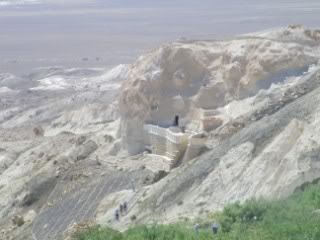 As promised in my post on Aktau, I want to write about the road trip to Beket-Ata. In Western Kazakhstan, there were a number of Sufi teachers who came and lived in caves in the area, running medressahs, consulting on difficult matters and healing people. They say there are 365 of these cave complexes (sometimes called underground mosques though they aren’t really mosques) in Mangistau. Many of them are still functioning as holy sites.
As promised in my post on Aktau, I want to write about the road trip to Beket-Ata. In Western Kazakhstan, there were a number of Sufi teachers who came and lived in caves in the area, running medressahs, consulting on difficult matters and healing people. They say there are 365 of these cave complexes (sometimes called underground mosques though they aren’t really mosques) in Mangistau. Many of them are still functioning as holy sites.
In fact, most historians agree that this is how Islam really came to the nomads. Because nomads were hard to pin down or conquer, it was mainly these traveling wise men like Beket-Ata and Shopan-Ata who brought the message of Islam. When there was some kind of problem or difficult decision to be made, Kazakhs or Turkmen would say, “Well let’s go see that guy who lives in that cave over there. I hear he has some kind of heavenly power.” If the Sufi’s advice was wise or he performed miracles, people would listen more and more to him and gradually accepted Islam as their faith.
So having heard of these places, unique to Mangistau, we thought we should go see some. A friend who lives out there called a tourist company on our behalf, and we were told that we really should go to Beket-Ata (which is both the name of the place and the Sufi mystic who taught there), which is the most famous and the largest of these complexes. I had seen a picture of it once and it looked impressive. We agreed until we started looking stuff up in the guide book before we got to Aktau. We noticed that there were two Beket-Atas on the map (in fact there are four–he had one for each season depending on how the nomads were migrating) and one of them was extremely far away from the town. We checked with our friend, who checked with the tourist company and were told that the Beket-Ata we were going to was about five hours out of town. We tried to convey the message that we didn’t want to drive for five hours to see one place and then turn around and drive another five hours back. Unfortunately this was all frustrated by the fact that we had to go through our friend. Half a day was spent phoning our friend, him phoning the company, then phoning us back, to clarify things and ask questions. We were finally assured that 1) going to Aktau without seeing Beket-Ata would be like going to Paris and not seeing the Eiffel Tower and 2) we would see lots of stuff on the way. In retrospect, I wish we had been able to convince them that we were okay with not seeing the Eiffel Tower, if it meant we got to see the Champs-Ellyesse, the Arc de Triomphe, the Parisian coffee shops and bakeries and the Louvre.
The day we got to Aktau, the day before we left for the holy sites, we were phoned at about 5pm by the administrator of the tour company to confirm that the driver would meet us at 10am in the lobby of the hotel. She gave us the name of the driver and the car number. Then the driver called to confirm that he would meet us. Finally at about 9pm some guy called me, speaking in English, saying he was a tour guide and would go with us. We had originally been led to believe that the driver was able to act as a guide, but since my friend didn’t speak Russian we were happy that we would have someone we knew spoke English.
10am the next day we come down and there’s no one there. We go out and there’s no one there. After 10 minutes we decide to start checking the three cars parked in the lot. We go up to one jeep and ask the driver, “Are you [insert driver’s name]?” He looks at me like I’m crazy and says, “Who is that? Who are you talking about? What do you mean?” I explain that we were waiting for a driver to take us on a tour and we thought it was him. Sorry for bothering you. We get a few meters away and he calls us, “Where are you going?”
“Beket-Ata,” I say.
“Oh, that’s me!” I’m a bit suspicious. He sees two foreigners and maybe he is thinking, I’ll take them a bit out of town and then rob them and leave them in a ditch somewhere. I try to call the guide but he isn’t answering his phone. The driver calls someone and then uses my name. That’s a good sign that he has talked to someone who knows me. We get in the car and immediately take off. I ask about the guide. Again the driver answers, “Who is that? What are you talking about?” I call the guide, who now doesn’t speak English at all, and am assured that all is ok. We start heading out of town. My friend and I are still a bit nervous. I try again to ask about the guide, Askar. The driver says, “Oh yeah, Askar. We’ll get Askar in about two hours.” I try calling Askar who says he will meet us at the hotel with a driver soon. At this point I panic, and the driver sensing this pulls over. I explain to Askar that we are in the car and about thirty minutes outside of the town. He says they must have sent a different driver and calls our driver who talks to Askar for a few minutes. Finally he clarifies that Askar lives about two hours outside Aktau and that we will pick him up on the way. And that we don’t have the driver or guide that we were promised the day before. When I tell the driver that we are a bit nervous of being robbed or abandoned, he throws his wallet full of ID at me. We are reassured although confused and continue on our way.
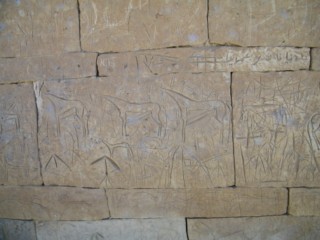
As we are bouncing through the desert outside Aktau, which looks a lot like West Texas, we see oil wells, camels, horses. We manage to get a little information out of the driver, but not much and we can’t seem to get him to pull over so we can take photographs. He finally promised to pull over at a nice spot, a canyon that marks the lowest point in Kazakhstan, about 200 meters below sea level. Very beautiful and the landscape there is amazing in how bleak it is. Many of my photos look black and white because there really is no color in the desert. However it is clear he wants to get under way again quickly. We later discovered that he was rushing us and trying not to stop too much because Beket-Ata is so far away and he wants to get there. Reason #1 not to go to Beket-Ata.
Finally we get to the village of Usyin and pick up our guide who apparently doesn’t speak English and is not actually a guide, just an administrator at the hotel we were staying in. He wasn’t a bad guide, but all in all we would have preferred someone who was a bit more knowledgeable and a bit better trained at guiding tourists. Because he wasn’t the same guy we had originally been assigned we also had to rehash everything, that we didn’t just want to drive straight to Beket-Ata and go back but also see some other sites. We later figure out that the “guide” probably agreed to go because he wanted to visit these holy sites himself.
Stop number one was the grave of the brother-in-law of Shopan-Ata. Shopan-Ata was the spiritual teacher of Beket-Ata. Apparently when Beket-Ata came to Shopan-Ata’s grave, he was moved with the spirit of Allah and immediately went to the Middle East to study Islam and become a Sufi. We never found out what was so great about the brother-in-law but the stone walls surrounding his grave was marked with stone carvings of horses, the arrow signifying the ancient Adai people, swords, the Muslim crescent moon, crosses, and even a version of tic-tac-toe. Apparently the carvings are all mixed up. Some of them are ancient and some may have been made a few days ago. This stop also marked the first time we went through the ritual we would repeat at every holy site. Walk around the grave the three times. Then sit while a man recited the Koran and then prayed. Apparently every shrine has a guy who sits there and waits for visitors so he can pray. He also keeps everything clean and in order. I can’t imagine being the poor schmuk who has to sit in the desert heat all day and wait for pilgrims. It’s an impressive commitment. He is probably supposed to meditate but I noticed some of them had newspapers and crossword puzzles stashed away.
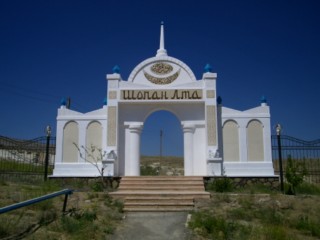
A short distance away was the complex of Shopan-Ata, which was much more impressive. We had a bit of a strange moment when we arrived and were told we would have to wash ourselves. I thought at first he meant we had to wash our feet to go into the mosque. Or perhaps we had to sort of symbolically wash ourselves by splashing water around a bit. But when we went into the bathroom stalls, it looked like the guide stripped down and washed his whole body. And while he was doing that he insisted that we at least wash our private areas.
The complex is pretty big. There’s the caves themselves where he prayed (and is now buried), where he slept, where students slept, and the classrooms. There’s a new mosque and a holy well whose water will cure you. And the whole thing is surrounded by an immense graveyard where his students and family are buried. Some of the graves were quite ancient, and some only a few years old. Some were nothing more than a pile of stones over the body or a simple stele and others were tombs the size of a small cottage. After we had toured everything, prayed before Shopan-Ata’s body and received a white sheet (to be tied around a holy tree or kept somewhere we want the blessings of Allah), we had to go the mosque and drink tea. Once again, there are women who apparently stay there all day and make tea, baurasaki and leposhki and lay the table with candy, fruits, and nuts for visitors. We didn’t eat in the prayer room obviously, but in a long hall clearly designed for the purpose.
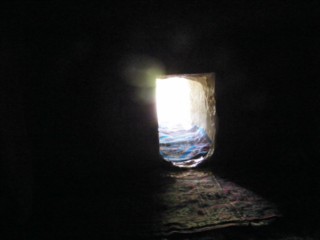 The two foreigners sitting at the table were quite a big hit. When we sat down we felt all the eyes turn to us. Then after a minute we heard people asking the guide questions in Kazakh and we caught words like “Amerikadan” and “Aktau” and so on. But of course no one talked to us directly, out of respect or shyness I suppose. It was kind of funny how all eyes watched us silently. I was generally surprised at how silent the table was. I had imagined that these groups of people, some of them apparently pilgrims from quite far away, didn’t intermingle more. I had expected that they would be talking to each other, asking where everyone was from, comparing experiences, and so on. Most people just sat down, drank tea, and left. I later noticed that some of the mosques also had separate rooms for men and women to lie down and sleep in.
The two foreigners sitting at the table were quite a big hit. When we sat down we felt all the eyes turn to us. Then after a minute we heard people asking the guide questions in Kazakh and we caught words like “Amerikadan” and “Aktau” and so on. But of course no one talked to us directly, out of respect or shyness I suppose. It was kind of funny how all eyes watched us silently. I was generally surprised at how silent the table was. I had imagined that these groups of people, some of them apparently pilgrims from quite far away, didn’t intermingle more. I had expected that they would be talking to each other, asking where everyone was from, comparing experiences, and so on. Most people just sat down, drank tea, and left. I later noticed that some of the mosques also had separate rooms for men and women to lie down and sleep in.
When we finished, the driver told us it would be another hour or so to Beket-Ata by the main road and then immediately got off the main road to go bouncing across the desert. We tried to ask where we were going and were told it was another grave site. Honestly at this point I felt two grave sites were enough for the tourists, but as we discovered it would be impossible to leave Aktau without visiting the grave of the geologist who first explored Mangistau and found oil there (I can’t remember his name now, and searches for famous geologists in Kazakhstan only bring me the name Kanysh Satpaev which doesn’t sound right). At this point, I started to get genuinely annoyed. We were being rushed along. We were traveling a long time in the car to see only grave sites and in four hours we had seen only 3 places. And now we had to pray over not a great Sufi but a geologist, not to mention his father and mother! This was also the only time I saw the guide acting very reverent and it was the only time the driver came with us to see the site (and pray). We were also told that if you left offerings at his grave, you would have good luck and blessings. I’m not clear on how a geologist is going to intervene with Allah for me but it was made clear that I should leave some money.
The positive side was that there was a nice spring near by called Kyzyl Sy or red water. Nice cold mountain water was exactly what we needed in the 98 degree heat. We also got a chance to stop on the way and see a shepherd’s flock while the shepherd slept. Interestingly he had a mixed flock of camels, horses, cows, sheep and goats. I would have thought they would be all kept separate. It was fun to watch the camels especially watching us. One baby camel literally followed every move we made. We also got to sit down with the keeper of the geologist’s grave. It turns out that he is a carver and carved the deer and saigak found at the entrances to many of these holy sites. However I didn’t remember until later that it is forbidden in Islam to make images of living beings so I didn’t have a chance to ask about that. Also during the inevitable tea, his wife disappeared and returned with boxes. We were told they were gifts and that we should wear them in good health. I had hoped it might be a skull cap or a robe or something Muslim. When we got to the car and opened it, we found they were Chinese made button-down shirts!
After that we finally started to approach Beket-Ata. But since this post is long enough as it is, I’ll save that for another time.
Comments are closed.
More in 'Tourism'
Culture
- Yurts Are High Fashion and Slum Fashion Too
2011-12-05 - Apples, Sure. But THC is from Kazakhstan too?
2011-10-05 - Naked Man Pot
2011-09-23
- Yurts Are High Fashion and Slum Fashion Too
Resources
- Oh, CNN
2012-07-21 - What Do You Know About Kazakhstan?
2012-07-19 - Books for Kazakh Students
2011-11-06
- Oh, CNN
Politics
- Image
2011-07-28 - Sub Rosa Endorsement
2011-07-26 - The Naked Truth
2011-06-12
- Image
News
- KZBlog is going down
2013-09-10 - Oh, CNN
2012-07-21 - Repentence
2012-07-15
- KZBlog is going down
Fun
- What Do You Know About Kazakhstan?
2012-07-19 - Yurts Are High Fashion and Slum Fashion Too
2011-12-05 - House Hunters Bishkek
2011-12-02
- What Do You Know About Kazakhstan?
Tourism
- Asian Games Torch
2011-01-12 - Wikitravel
2010-08-07 - ALZHIR, the Soviets and Democracy
2010-07-30
- Asian Games Torch
Life in KZ
- Photo Gallery: Almaty Subway
2011-12-07 - Healthcare and the Private Sector
2011-11-30 - Naked Man Pot
2011-09-23
- Photo Gallery: Almaty Subway


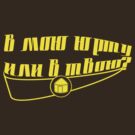

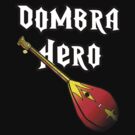





[…] I’ll post on our trip out into the desert to see the underground mosque of Beket-Ata. EDIT: the road to Beket Ata is […]
Firstly, its alright to make images, its the fundamentalist arabs who have made such rules. Secondly, you journey was a very annoying one, but let me tell you visiting the site of that sufi master, you have no idea what you received from it..we think that we are going to the grave, but it is actually them calling you and from what you have described you were not willing to, yet somehow situation was created where you had no other choice. just wait and see how your life moulds in a few year.. observe your life….
Regards//
I know times change, but it is in the Koran that making pictures is forbidden and I wonder when you are dealing with a holy site whether one shouldn’t be a little strict? I mean Christians can drink but I wouldn’t want to do vodka shots in church.
just came from this place……wonderful feelings…..seems like i have more power…….amazing views and nature
Glad you enjoyed it. The views and the nature are indeed amazing. Someday I will write up my actual experiences at Beket Ata itself.